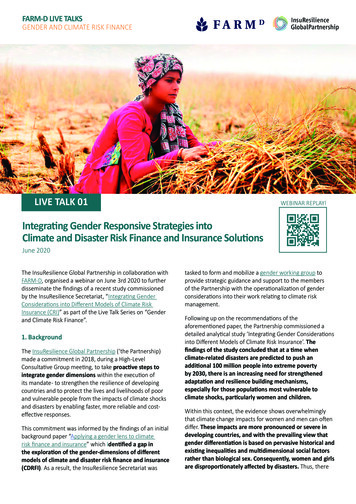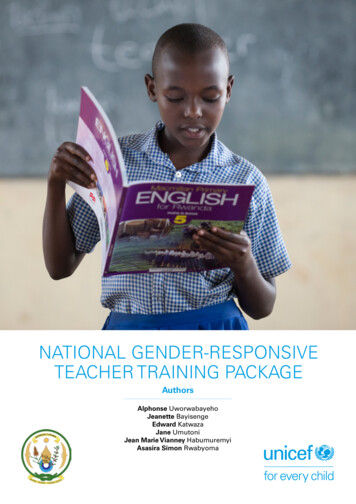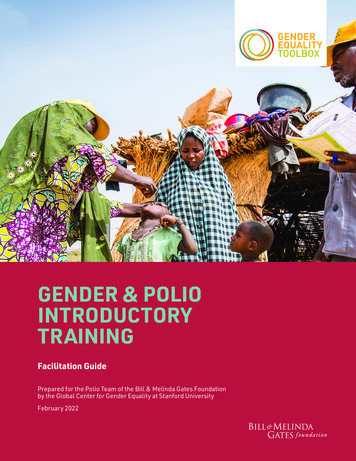
Transcription
FARM-D LIVE TALKSGENDER AND CLIMATE RISK FINANCELIVE TALK 01WEBINAR REPLAY!Integrating Gender Responsive Strategies intoClimate and Disaster Risk Finance and Insurance SolutionsJune 2020The InsuResilience Global Partnership in collaboration withFARM-D, organised a webinar on June 3rd 2020 to furtherdisseminate the findings of a recent study commissionedby the InsuResilience Secretariat, “Integrating GenderConsiderations into Different Models of Climate RiskInsurance (CRI)” as part of the Live Talk Series on “Genderand Climate Risk Finance”.1. BackgroundThe InsuResilience Global Partnership (‘the Partnership)made a commitment in 2018, during a High-LevelConsultative Group meeting, to take proactive steps tointegrate gender dimensions within the execution ofits mandate - to strengthen the resilience of developingcountries and to protect the lives and livelihoods of poorand vulnerable people from the impacts of climate shocksand disasters by enabling faster, more reliable and costeffective responses.This commitment was informed by the findings of an initialbackground paper “Applying a gender lens to climaterisk finance and insurance” which identified a gap inthe exploration of the gender-dimensions of differentmodels of climate and disaster risk finance and insurance(CDRFI). As a result, the InsuResilience Secretariat wastasked to form and mobilize a gender working group toprovide strategic guidance and support to the membersof the Partnership with the operationalization of genderconsiderations into their work relating to climate riskmanagement.Following up on the recommendations of theaforementioned paper, the Partnership commissioned adetailed analytical study ‘Integrating Gender Considerationsinto Different Models of Climate Risk Insurance’. Thefindings of the study concluded that at a time whenclimate-related disasters are predicted to push anadditional 100 million people into extreme povertyby 2030, there is an increasing need for strengthenedadaptation and resilience building mechanisms,especially for those populations most vulnerable toclimate shocks, particularly women and children.Within this context, the evidence shows overwhelminglythat climate change impacts for women and men can oftendiffer. These impacts are more pronounced or severe indeveloping countries, and with the prevailing view thatgender differentiation is based on pervasive historical andexisting inequalities and multidimensional social factorsrather than biological sex. Consequently, women and girlsare disproportionately affected by disasters. Thus, there
// LIVE TALK 01is a clear imperative to consider the gender-dimensionsof CDRFI. Yet, the question remains how can genderconsiderations be successfully incorporated to enhancegovernment development policies, plans and programswhilst ensuring that women are given the platform tobecome powerful agents of change.4. Objectives and structure of the webinar2. Speakers and moderatorsThe objectives of this webinar were to: Vitumbiko Chinoko – Advocacy and PartnershipsCoordinator, Climate Change and Food Security,Southern Africa Region, CARE International and Cochair to the InsuResilience Gender Working Group.Katherine Miles – Gender Consultant to theInsuResilience SecretariatMartina Wiedmaier-Pfister – Gender Consultant tothe InsuResilience SecretariatChristiana A. George – Gender Advisor at the AfricanRisk Capacity (ARC)Emily Coleman – Agricultural Insurance Technical Lead,INSURED, Platform for Agricultural Risk Management(PARM), International Fund for AgriculturalDevelopment (IFAD)Astrid Zwick - Head of InsuResilience Secretariat3. ParticipantsThe webinar hosted a total of 139 participants and offeredan opportunity for participants to share experiences,best practices and challenges of those incorporatinggender considerations into different climate risk insuranceschemes.The purpose of the webinar series is to gather insights ofvarious stakeholders to inform guidance material beingdeveloped on how to include gender-smart solutions underthe InsuResilience Global Partnership’s broader mandate.Provide key insights on the rationale and models ofgender-sensitive approaches as presented in the recentInsuResilience Global Partnership study “IntegratingGender Considerations into Different Models of ClimateRisk Insurance”;Present and share concrete examples of existinggender responsive CDRFI approaches and goodpractices; andInform the development of guidance anddocumentation to be developed on gender-responsiveCDRFI approaches as part of the InsuResilience GlobalPartnership gender action plan. The webinar was divided into two parts. The first, providedkey information of the findings of the above-mentionedstudy, and in the second part, participants were separatedinto two groups to interact and share their experiences ongender-responsive approaches under i) micro and mesoCRI schemes; and ii) macro CRI schemes. This was followedby a plenary session where the key findings of the twobreakout groups were presented and recommendationsdiscussed. The webinar also included polling questions toascertain data on current activities within the landscape ofgender-responsive approaches to CDRFI. Below are the keyoutcomes of the sessions.Box 1Participants at a GlanceFig. 1 - Participants by type of organization8%Fig. 2 - Participants by geographical region8%13%15%16%40%Academia / ResearchDevelopment / Multilateral AgencyFarmers OrganizationFreelance / IndependentGovernment10%41%Non-Profit Organization1%Latin America & and CaribbeanMiddle East & North AfricaNorth America11%Sub-Saharan AfricaPrivate Sector12%1%Asia & the PacificEurope25%
Box 2Webinar AgendaOpening RemarksVitumbiko ChinokoSESSION 1 - PlenaryGender-responsive Approaches to Climate RiskFinance and Insurance in TheoryKatherineMilesMartinaWeidmaierPfisterSESSION 2 - Breakout GroupsGender-responsive Approaches to Climate RiskFinance and Insurance in PracticeChristianaA. GeorgeEmilyColemanWay Forward and Closing RemarksVitumbikoChinokoAstridZwickOPENING REMARKSSpeaker: Vitumbiko Chinoko, CARE International and Cochair to the InsuResilience Gender Working Group.The webinar was opened with remarks from Mr.Vitumbiko Chinoko, Co-chair of the Gender Working Groupof the InsuResilience Global Partnership and Advocacy andPartnerships Coordinator at CARE International. Mr Chinokohighlighted the importance of advancing gender-responsiveinvestment and development planning in the climateand disaster risk management framework. He shared hisgrassroots experience at CARE International, where theyhave observed that disasters don’t affect women, men, girlsproportionately. Furthermore, financial products readilyavailable to women, such as savings and loans are useddifferently by men and the benefits of using such tools bywomen are far more impactful on a community. Womenhave been identified as having a longer-term focus thataims to strengthen the social network within a communitywhilst enhancing climate resilient activities such as thepurchase of resilient seedlings. Mr Chinoko concluded byreiterating that including women throughout disaster riskfinance frameworks offers a unique perspective that is tothe benefit of families and the broader community, as aresult it is of paramount importance to align approaches tobe more inclusive to women.SESSION 1Gender-Responsive Approaches To Climate AndDisaster Risk Finance And Insurance In TheorySpeakers: Katherine Miles, InsuResilience SecretariatGender Consultant and Martina Wiedmaier-Pfister,InsuResilience Secretariat Gender ConsultantUnder the commissioned study, the main researchobjective was to explore the case and main entry points for// Page 3
// LIVE TALK 01Fig. 3 - Cover studyBox 3Plenary Poll**based on participants answers1. Have you implemented gender-responsive approachesto climate and disaster risk finance and insurancesolutions or supported others do to so?Yes51%NoN/a32%17%2. Do you have an institutional gender policy?YesNoN/aintegrating gender and a focus on women into different CRIschemes and provider types at the macro, meso and microlevels.The following are the key outcomes of the study: There is a clear policy imperative to integrate genderresponsive approaches into climate risk financingand insurance solutions, as climate change impactswomen and men differently. Global agendas undermultiple international policy priorities and globalcommitments1 have already begun to integrate genderconsiderations, yet they have not considered theintersection with and role of climate risk insurance.There are varied levels of understanding on the genderdimensions of macro-, meso- and micro- level CRI andthe value of gender-responsive approaches. Uponwhich the study identified various entry levels undereach level. Regarding macro level schemes, the studyidentified how both regional risk pools and nationalCRI schemes can integrate gender-responsiveapproaches. The African Risk Capacity (ARC) is oneexample provided that adopted an institutionalgender policy after a one-year consultation process. 66%14%20%There is a great opportunity for contingencyplans, such as those developed as part of ARC scountry projects, to be gender-responsive in theirdevelopment process, consultation, and content,and to draw on sex-disaggregated data to informpayout priorities. But currently there are genderdata gaps on how the payouts have been used,both in terms of who has received them, and theimpact the payouts have had.At the meso-level, it was identified that there isa need for more pilots, which target institutionalpolicyholders that aggregate female clients,members or employees. Selecting institutionalpolicyholders that aggregate female clients (like theabove MFI networks), members or employees (likethe cooperatives and mutuals) – both a naturallyemerging entry point.Women-specific micro-level CRI schemes providea huge opportunity by focusing on specializedaggregators and women-led value chains.Partnerships with distribution channels thataggregate large numbers of women – such as theglobal MFI- networks Women’s World Banking (31countries), ACCION International (50 countries) andFINCA International (44 countries) active in manycountries and regions, which can be a powerfulentry point.such as the UNFCCC enhanced Lima work programme on gender and its gender action plan, Sendai Framework, Sustainable Development Goals and theAccess to Financial Inclusion (AFI) Denarau Action Plan.1
Overall, these gender-responsive approaches identifiedare a good start but by far not up to the potentialthey could have, if implemented more broadly, andconsistently. The identified gender-responsive approaches havebeen successful but lack a systematic and strategicgender focus that will ensure the sustainability ofthe approaches.Sex-disaggregated data in the rare cases whencollected is often not analyzed or used to informproduct design or indicate gender impacts.The levels of female leadership and participation inthe workforce of CRI schemes is unknown.There is a guidance gap on gender-responsiveapproaches to CRI practices and a lack of goodpractice evidence and data on existing genderrelated practices.The study proposes short-, medium- and longer-termrecommendations relating to the work under theInsuResilience Global Partnership to increase awarenessand drive practices to increase gender-equitable access toand impact of CDRFI. For the short term: for example, sex-disaggregateInsuResilience Global Partnership s Vision 2025 target of 500 million poor and vulnerable people, and provideguidance to collect gender and sex-disaggregatedimpact data of schemes.In the medium term, integrate gender lens criteriain investment decision making of future schemes;adapting infrastructure to collect sex-disaggregateddata; and to create an advisory facility to supportschemes which integrate gender, and to fund thecollection of learnings and good practice of what worksand what doesn’t.In the longer term, ensure disaster data is sexdisaggregated for the V20 countries, that genderconsiderations and use sex-disaggregated data in itsrisk modelling, existing disaster databases, and tosupport the creation of vulnerability mapsSESSION 2Gender-Responsive Approaches To Climate AndDisaster Risk Finance And Insurance In PracticeParticipants of the webinar were divided into two breakoutsessions, one focused on the macro level and one on themeso and micro levels. The outcomes of these sharingsessions provide insights on how the different models couldbe more gender responsive, how to improve the value ofthese models, and on the roles of different stakeholders insupporting gender responsive CDRFI models at all levels.// Page 5
// LIVE TALK 01Micro and Meso models of CDRFIModerators: Katherine Miles, InsuResilience SecretariatGender Consultant, Emily Coleman – Agricultural InsuranceTechnical Lead, INSURED / PARM, International Fund forAgricultural Development (IFAD)Under the micro and meso breakout session, two pollquestions were initiated: the first set of poll questionssought to explore whether the participants have beeninvolved in the implementation of CRI products andschemes; whether proactive steps have been taken toidentify gender difference in risks to inform productsdesign; and had any participants taken steps to supportthe distribution and servicing of women clients. Theresults revealed that only one participant had worked onimplementing CRI products, with a few participants havingalready taken steps to identify the differential risks andimpacts of climate disasters on women. The second polllooked at the collection of sex-disaggregated date withthe majority of participants actively collecting but fewconducted evaluations to understand better the differentialimpact if CRI pay-outs on beneficiaries.flagship program. The outcome of integrating genderconsideration in the design and implementation ofthe program is that 60% of the beneficiary farmersare women in the project countries – Malawi, Kenya,Zimbabwe, Ethiopia, Senegal, Burkina Faso andZambia. Participatory processes could be made moreeffective by designing applications with memorytriggers to understand impact of risk i.e. the differentways women and men recollect bad climate events,and how it impacts on their daily lives. For example,this approach has been undertaken by InternationalResearch Institute for Climate and Society (IRI) throughthe use of a gamification tool. There is a need to consider accessibility issueswhich could create gender biases within projects.For example, mobile phone access, applications,connections to web may be different between menand women. Therefore, if a project implements aparticipatory process which relies on mobile phoneaccess, women may be unfairly represented in thisexercise. Such research is necessary in the designphase of programs to better understand the genderdifferences and risks of the different client groups andidentify the distribution channels of CDRFI schemeseither directly or through partners. Institutional policy frameworks could supportgender-responsive approaches across projects.The case for gender consideration in the designand implementation and in the collection of sexdisaggregated data, like in the case of Platform forAgricultural Risk Management (PARM), stems frominstitutional policies that aim to support both womenand men in agricultural insurance management andbecause gender consideration is a requirement fromdonor agencies.Key discussion points: Sex-disaggregated data is important for genderresponsive product design, implementation andevaluation, as it is important to understand how menand women experience impacts of disasters differentlyand how the solutions could be tailored on the basis ofthis understanding. It is also important for identifyinggender barriers within programs and provides insightsinto how a program could be adapted to removeidentified barriers. A comprehensive monitoring,evaluation and assessment system captures sexdisaggregated data from generic household data andshows the evolution and impacts of the scheme/program. Gender disaggregated data and informationfrom impact assessments and project surveys isvaluable input for scaling up and designing newprojects. An example is the planned survey by GlobalIndex Insurance Facility (GIIF) in three project countriesto provide insights and guidelines on beneficiarybehaviours, household characteristics and availableproducts on the market towards designing the nextphase of their projects in these countries.Gender-responsive participatory processes should beimplemented in all phases of projects, including thedesign, implementation, monitoring and evaluation.In this way, barriers to gender integration is notoverlooked, and project activities are tailored tothe needs of women and men. Evidence of genderinclusive participatory approaches is observed in theR4 Rural Resilience Initiative, a World Food ProgrammeMacro models of CDRFIModerators: Martina Wiedmaier-Pfister – Genderconsultant to the InsuResilience Secretariat, ChristianaGeorge – Gender Advisor at the African Risk Capacity (ARC)For an overview of the general standing of the participants,polls were conducted. They summarised that half of thebreakout session’s participants were already designing orimplementing gender-responsive approaches while 25% areplanning to do so. The concrete stage of gender-responsiveclimate risk insurances was mainly defined as in an earlystage from almost 50% of the participants and only 25%mature. Nevertheless, the participants expressed highmotivation and keen interested to develop in this process.Gender-disaggregated reporting should be a requirementwithin macro CRI schemes. As these schemes typically
provide payouts to national governments, currentreporting data is usually at a high level, siting sectorswhich were allocated payout, but not reporting on genderimpact of payout. Projects should mandate genderresponsive measures to ensure gender-responsive design,implementation and reporting. For example, the AfricanRisk Capacity, has now integrated gender-responsiverequirements in government reporting on payout use.Strategic frameworks could ensure integration ofgender-responsive approaches as a cross cuttingpriority for an organisation. Assessing the needs ofwomen can be integrated across all activities as well as inorganizations and institutions themselves. For example,CARE International have undertaken an organisationwide approach, by briefing every staff member to bea “gender ambassador” in all their work activities andprovided the relevant training to equip them to succeedin this role. Similar knowledge exchanges and trainingcould be extended to responsible officials in government sparticipating in macro CRI schemes.Measures to ensure gender-responsiveness could beintegrated within macro CRI schemes. For example, inthe African Risk Capacity, governments are required tointegrate gender in their contingency plans, which detailthe use of a potential payout and are a prerequisite forparticipation in the program. This could be an approachto define how insurance payouts should be utilised withconsideration for the different effects for women and couldinclude safeguarding measures such as beneficiary checksand feedbacks.WAY FORWARD AND CLOSING REMARKSSpeaker: Vitumbiko Chinoko, CARE International and Cochair to the InsuResilience Gender Working Group andAstrid Zwick, Head of InsuResilience SecretariatThe webinar illustrated the necessity of developing andimplementing policies for integrating gender dimensionsin DRM strategies and broader development work on alllevels. Since data is critical to designing gender-sensitiveDRM and financing, governments and developmentpartners should invest in developing tools and frameworksthat will capture relevant data to inform comprehensiveDRM strategies. The insights from this webinar will serve asinputs for developing guidance material for the activities ofthe InsuResilience Global Partnership.As such, this webinar lays the foundation for subsequentsessions that will allow deep dives into key issues relatedto gender and CDRFI. The next webinar “DemonstratingImpact: Gender-responsive CDRFI and Data Challenges”will be held in September. The Partnership encourages allstakeholders to use the interactive platform Risk Talk to askquestions and continue discussions relating to climate riskmanagement solutions.WEBINARREPLAY
FARM-D LIVE TALKSGENDER AND CLIMATE RISK FINANCECOMING NEXTLIVE TALK 02 September 2020Demonstrating Impact:How to monitor and evaluate genderresponsive climate and disaster riskfinance and insurance schemes?Follow FARM-D and the InsuResilience GlobalPartnership Websites for more information.Let’s Keep the TALK!RISK TALKOnline exchange community onclimate risk management solutions.SCAN MEFORUM FOR AGRICULTURAL RISKMANAGEMENT IN DEVELOPMENT(FARM-D)SCAN MEInsuResilience SecretariatFriedrich-Ebert-Allee 4053113 Bonn, ience.orgYour Community for knowledgeexchange on #agrisk managementsolutions.FARM-DPlatform for Agricultural Risk Management (PARM)International Fund for Agricultural Development (IFAD)Via Paolo di Dono, 40 - 00142 Rome, Italyparm@ifad.org; info@farm-d.orgwww.parm.org www.farm-d.org
Risk Insurance"; Present and share concrete examples of existing gender responsive CDRFI approaches and good practices; and Inform the development of guidance and documentation to be developed on gender-responsive CDRFI approaches as part of the InsuResilience Global Partnership gender action plan. The webinar was divided into two parts.










